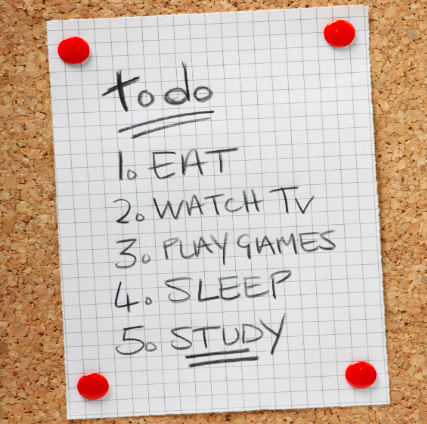Got a procrastinator in your home?
Then you know the struggle.
You ask your child to start their homework. When you check in 20 minutes later, they are sitting in front of the TV, no homework in sight. Been there before? It’s frustrating, right?
Papers that pop up the day before the due date. Cramming for tests early in the morning and project supply runs late at night. It seems like everything gets pushed off until the last possible minute! It leaves you and your child tired and stressed out.
You aren’t alone. A lot of children and young adults procrastinate. As adults, we’ve learned to cope with a neverending to-do list. But with less life experience, our children have far fewer tools in their procrastination toolbox.
The good news is that your student can learn the skills necessary to manage their responsibilities.
HiveWheel is here to help you take your student from procrastination to productivity!
Procrastination. It’s a problem! Why does your kid always do it??
Why do we procrastinate even when we know it is bad for us? Our brain is hard-wired to find short-term pleasure, and schoolwork isn’t it. Our brain also seeks out the path of least resistance, or the easiest path. Scrolling through TikTok requires less mental energy than studying for an algebra exam. It also distracts us from the anxiety, boredom, or other uncomfortable feelings studying brings up. Our brain is very skilled at zeroing in on what will make us feel good in this moment. This is why our kids love to put hard things off until “later”.
Students procrastinate for a variety of reasons. They may feel overwhelmed. They may fear making mistakes or think it will take forever to finish their work. Some kids simply find it difficult to keep their minds from wandering when a task doesn’t interest them. Often executive dysfunction, such as poor time management, weak working memory or lack of self-discipline, is also at play. There are many possible reasons your child procrastinates, so it’s helpful to unpack what triggers them. A HiveWheel coach can help your student identify their triggers and create a personalized game plan for overcoming them.
Do you recognize the following procrastination pitfalls in your child?
- Projects are started at the last minute
- Homework is overwhelming or difficult to start
- Fun activities take priority over homework and studying
- Multiple reminders are needed before homework and chores are begun

Sound familiar? We have five tips to help:
1. Eliminate Tech

Technology is everywhere and inescapable. Netflix, Tiktok, Youtube, Snapchat– our devices give our brains no shortage of possible procrastination pit stops. And that’s a BIG problem for students who are easily distracted.
Here’s how to get your child to disengage from the devices and focus:
- Turn their phone on silent and put it out of sight, ideally in another room.
- Have an external calculator for homework, rather than the one on their phone or computer.
- If your student is working on a laptop, use website blocking tools to block potentially distracting websites. Freedom is a program that allows you to block specific sites during study times. StayFocused is a Chrome extension that allows you to set a daily time limit on distracting websites. Once your student has maxed out their time, the site will be blocked until the next day.
2. Reduce Anxiety and Overwhelm
If anxiety has your student procrastinating, tackle it head-on. Trying to force our anxiety away makes it even worse. Instead, name the anxiety and challenge it.
What are you most afraid will happen? What else could happen? Do you know for certain the worst case will happen? Rarely are the worst-case scenarios we imagine the actual outcome of a situation.
Here’s a simple breathing technique to calm down the body and focus the mind:
- Relax your jaw and shoulders.
- Breathe in through your nose for 4 seconds.
- Hold your breath for 5.
- Then breathe out through your mouth with a “whoosh” sound for 6.
- Repeat 3 times.
3. Start With the Easy Stuff!
Sometimes we look at our workload and there are so many things to do, we don’t even know where to begin. It can feel so overwhelming! Your child feels the same way. It’s easy to get stuck in a loop of doing nothing because of anxiety, then feeling more anxiety because you did nothing. You just need to start something.
Encourage your student to make a list of everything they need to do, and do one of the easiest tasks first. Now have them cross that task off their list! They did it! Crossing tasks off of a list will help them visualize their progress. Now, they can use that momentum to take on harder tasks.
4. Rewards for Meeting Goals
Work with your student to come up with a simple and attainable goal. Then choose a reward to go with it. For example, “If I work on my project for 30 minutes each day after school, then I will have time to (insert fun activity) on Saturday.”
The if-then strategy reframes your child’s internal dialogue from negatives to positives. Procrastinators work from a space of avoidance. Avoidant behaviors get reinforced because they help your student ignore tough emotions. This approach shifts your child’s mindset from “How can I avoid feeling bad right now?” to “What can I do to help my future self feel good?” This breaks the negative reinforcement cycle and transforms avoidance into action.
5. The “Do it now” Rule
Do chores always seem to fall to the wayside? Have your child implement the “Do It Now” rule: If you see something that needs to be done, do it now or schedule a time to do it later. If the task can be completed in just a few minutes, it should always be done as soon as you notice it.
6. The “Five Minute” Rule
You can do anything for just five minutes!
Set a timer for five minutes and agree to work on a task wholeheartedly until the timer goes off. Then it’s your child’s decision to either keep working or take a break.
This tip works best when there isn’t a pressing deadline. If your student is struggling to start a paper or project, this removes the pressure of completing the task and gets them directly into work mode. Even if your child chooses not to continue with the task, that’s five more minutes worth of finished work.
7. Schedule Breaks

Short breaks every 25 minutes give your brain a chance to rest and refocus before your thoughts have a chance to wander.
Set a timer for 25 minutes and give the task at hand full attention. When the timer goes off, it’s break time! Reset the timer for 5 minutes. Repeat this for two or three cycles, then schedule a longer 30-minute break.
On shorter breaks, your child could listen to some relaxing music, eat a snack, or do some deep breathing. On longer breaks, they could read a chapter from a book or text their friends back. Try to avoid devices during shorter breaks and use them sparingly on longer breaks.
It may sound counterintuitive, but scheduling breaks at regular intervals helps us be more productive.
These tips will help your busy bee leave procrastination bee-hind!


Recent Comments